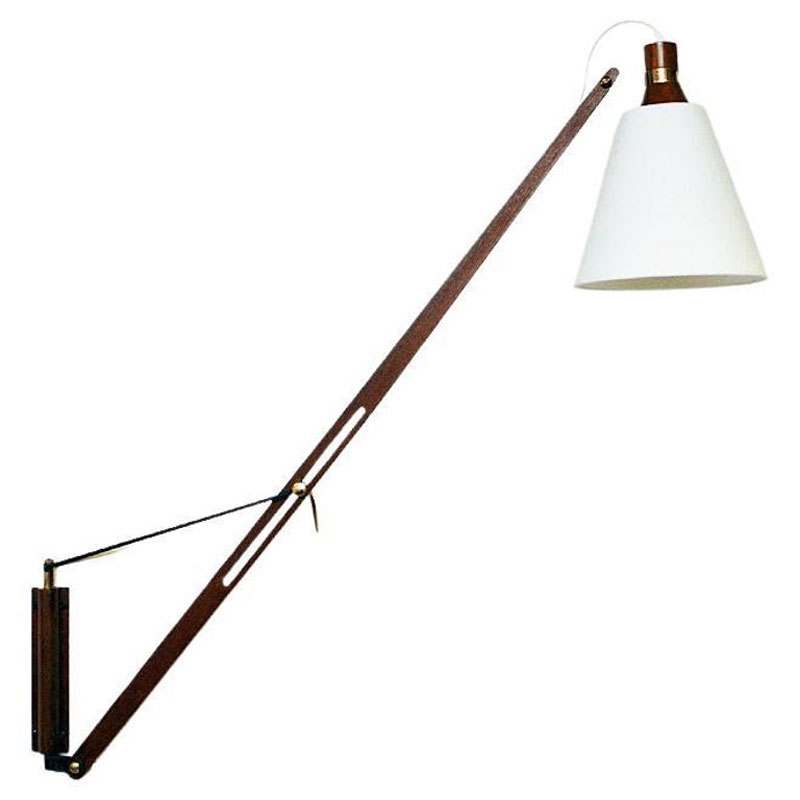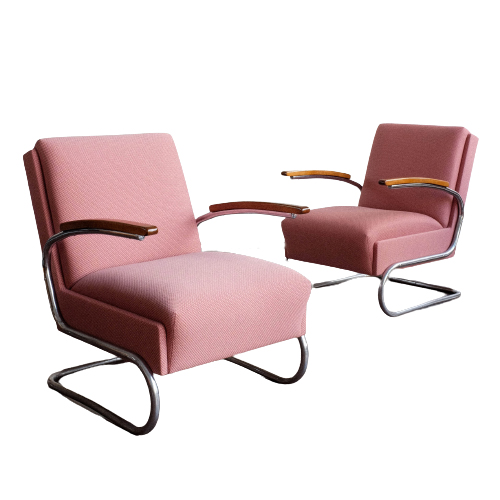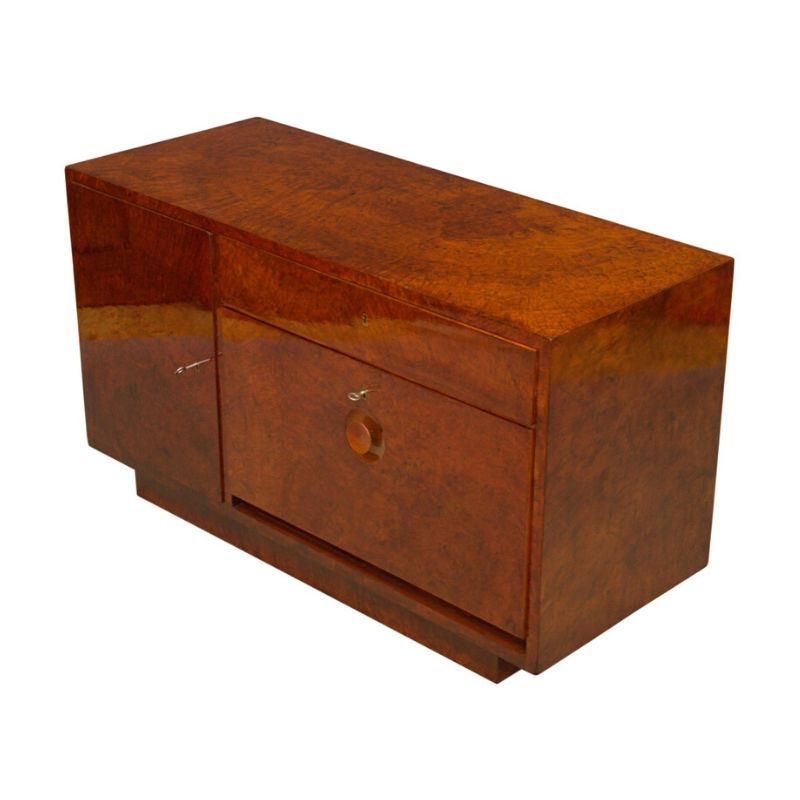I saw a desk in a thrift store that looked like it might be design significant. It consisted of formica desk top supported on a black annodized frame with a two drawer stack on the right made of wood. The desk top and the drawer stack were connected by metal tubes that extended diagonally down from the desk top to the drawer stack and then bent upwards on that outside of the drawer stack. Wish I had a picture of this, but I didn't have a camera with me. I couldn't find any markings, but it looked 50s-60s. Anybody seen anything like this? Any link to a picture, or to an image archive of desks that might look like this would be appreciated too.
Dear Andyallen
If you take a few minutes of your precious time you will finf that our friend dcwilson has been with the forum for quite some time and is without any doubt the participant that has filled the most virtual pages of all of us. In fact he is the author of the most pertinent questions and comments that have been made...
It's worth to look out dfor them and read them.
Funny, isn't it. . .
It's almost like we need a whole new written vocabulary, today. Did our parents and grandparents, who wrote letters daily as a matter of course, have the same problem ?
I admit to using "emoticons" where available -- but I hate them, in fact. What's a writer to do ?
I do not know about writing,...
but in design we learn that if you use humor or irony you have to combine it with a demonstration of "good" design or proper undertsanding of the product some of Alessi's or Koziol's product are good demonstrations of it. The contrast between the "funny" part and the serious part makes the user or observer understand that the funny part is intentional and not another garden gnome. Philippe Starck's fixtures do that quite well to. The proportion betweeen shade and rifle is good and he does not give in to temptations like making the trigger into the lamp switch...but it is borderline. Translated in writing one could do the same thing. In this case I think more of us would have understood the humor if something had been added to show that dcwilson is indeed well known on the forum like..." you must be new to the forums - a photo would really help us out, as well as a lengthy and elaborate essay in which I personally encourage the use of as many unusual words as possible..." I lack the talent to make it work, but I hope you understand my intention...So could writing be designed?
Good writing IS designed...Designs future may be redesigned...Pt.1
Writers in all genres of writing have tools to work with just like designers do.
Writers use words, phrases, sentences, cadences, rhymes, diction, punctuation, paragraphs, chapters, dialogue, metaphor, similie, symbolism, and mythology the way designers uses line, scale, massing symmetries, color, references and probably much more I do not know about.
Writers work in literary forms, like the novel, the limerick, epic poetry, 1 act stage plays, 3 act stage plays, 5 act stage plays, 3 act screen plays, sonnets, haiku, etc., the way designers work spatial forms such as chairs, tables, interiors, houses, office buildings, public spaces, etc.
Writers, like designers, try to build on earlier forms and yet try to avoid cliches. Writers like to steal from other writers perhaps more than designers steal from other designers, but I am not a designer, so I cannot be sure. Great writers are cunning in their stealing. They steal only what works and they usually steal it from writers no one in their own audience and culture has ever heard of. At the same time, they pay homage to great writers familiar to all, some times out of a love of that great writers work and some times as a means of furthering communication based on contrast. Hemingway paid homage to Mark Twain, and to a lesser extent Stendal, and attributed his cadence to news style over the western union wire, but actually stold his cadences from Tolstoy, who at the time was little known to American audiences. He never mentioned aping Tolstoy and only superficially revealled his debt to Russian literature in his Paris memoir "A Moveable Feast."
Some of the above you probably got in English 101 and it bored you to tears and so you lost interest in literature as a creative outlet for yourselves, just as I had my early interest in design squeezed from me by automaton wood and metal shop teachers who cared more about reducing design to lifeless schematics precisely rendered to allow the building of uninteresting objects, than lively, elegant design solutions skillfully schematized and fabricated with craftsmanship.
Well, I'm here to tell you that writing and design have ALOT in commmon, even though writers work in a fundamentally linear medium (sentences that say this, and then this, and then this, and then this and which are experienced in the same linear order) and designers that work in a very simultaneous medium (all the design elements cohere simultaneously and are experienced simultaneously).
Good writing IS designed...Designs future may be redesigned...Pt.2
Now I can almost hear some of you designers saying, "that's an over simplication of design, DC. Certain kinds of design, like architecture, has a design program that you can experience linearly." And you would be absolutely correct. And certain kinds of literature have an architectural dimension to them that makes literature be experienced in more simultaneity. For example, Chaucer's "The Canterbury Tales" are quite consciously designed not only around the conceit of a carriage trip to Canterbury, but simultaneously around the architecture of the Canterbury cathedral itself. The tales are told from the carriage in a very linear way. But the symbolism, imagery and so forth frequently take on the characteristics of a walk around or through the Canterbury cathedral. The tales are filled with the literary equivalents of gargoyles and spires and hidden passages and so forth that create at least the literary simulation of simultaneity of experience found in an architectural program. It is even contructed so that one can read the tales in various orders just as one can walk through and around Canterbury Cathedral in any number of orders.
Similarly, James Joyce's Finnegan's Wake, probably the most brilliant and difficult comic novel ever written, is constructed around the conceit of an epic dream of a drunk. A guy walks in the pub of an inn, ties one on, cries in his beer to the bar tender about his troubles and his family, and then retires to sleep it off. All very linear, right? But then Joyce dares to tell the story of the entire Irish Race in one night's dream. Dreams as you know, are quite linear and quite simulaneous. The linearity of time breaks down in dreams. Things and people morph from one thing into another thing. Persons play many roles in dreams. In some of their varied roles, their real identities are apparent. In other roles, their identities are concealed almost completely. Joyce lets his family members and the people in the pub play all the roles in the drunk's dream of the Irish race from pagan times to Christian times to modern times. His children show up as all manner of children in Irish history. He and his wife show up as all manner of couples. And in almost every sentence Joyce is punning brilliantly on various levels of meaning to simulate the strange quality in dreams of images and words taking on multiple meanings. Joyce entirely "designed" this novel. It can be experienced linearly and as one gets the hang of it, if one gets the hang of it, it accumulates into the litereary equivalent of simultaneity of experience.
So: mundane writers produce mundane writing which is quite literally a linear experience and often very dull because of it. Likewise, mundane designers produce mundane chairs which one experiences as little more than the simultaneity of sitting.
Good writing IS designed...Designs future may be redesigned...Pt.3
Great writers, on the other hand, are designers working in words. They will build you a linearity with some simultaneity you can read in, just as surely as great designers will build you a simultaneity with some linearity you can walk through.
Now, if you will bear with me toward one further connection, consider the writer and the designer at two poles and then insert the computer programmer between the two of them. One day, perhaps 50 or 100 years from now, computer programmers will hopefully begin to be understood as the digital pivot point between writers and designers. One day, I hope, computer programmers will take on the cultural stature that writers and designers have. One day, I hope their capacity for elegance and beauty will be elevated both as a standard for them to aspire to and also as a taste we should all aspire to. So far, most computer programmers have tended toward being engineers at heart. But as the more imaginative among them have found their ways into digital animation and CAD, an awareness has begun to dawn that they too are designers. Right now they are treated like the digital equivalent of cinematographers, which is I think unfortunate. Computer programmers have already revolutionized entertainment effects with digitalization. But still they are largely hired crafts persons in the movies. You have to get into computer games before you can see the amazingly unique sensibilities of these computer programmer/designers altering the sensibility of society. There are going to be great computer programmer/designers one day, person's whose stamp of genius and/or personality is unmistakeable. This will be all to the good.
Good writing IS designed...Designs future may be redesigned...Pt.4
A computer program distills to this: input, algorithm, output. That is a three act play. Create a cast of characters called variables. Give this cast of characters/variables something to do called an algorithm. Then watch what happens in the climax of output. Computer programming is quite linear in the sense of line by line code telling a computer what to do. In this respect, it is quite like writing. But it also has the digital equivalent of an architectural program and can create both the experience of linearity and simultaneity. Plus it can allow interactivity the way certain kinds of writing and all kinds of design permit. By this I mean computer programming can create digital artificats that allow a person/consumer to interact with it along programmed paths.
But computer programming can be more facile in one way than either writing or design. It can facilitate what i call intercreativity. It can allow a person/consumer to morph games and stories into almost anything. In this regard, computer programming allows the person/consumer to take on much more of the role of the writer or designer, or a co-writer or co-desiger, if you will. The capacity and effect I am describing is akin, for sake of clarifying analogy, to when I start to tell my child a story and then he takes off and runs with it in a direction I never dreamed of.
This intercreativity, i.e., this springboarding from the program into completely unforeseeable experience and effects is not without precedent, of course. All artifacts and architecture that have ever been made have been put to uses that the maker never intended or foresaw. But the computer programming artist/designer/writer I envision in the future will be someone who becomes at long last expert in the devising of computer programs that intentionally aim at creating artifacts that encourage this.
Good writing IS designed...Designs future may be redesigned...Pt.5
Many relatively open ended computer games like the Sims already hint at this future, so I think I am not forecasting the future as commenting on the rudiments of it that are already here. Why does this matter to writers and designers? Because writers and designers must always adapt to new media and adapt forms to that new media. I suspect that the renaissance writer/designer of the future is apt to be a computer programmer, at least in the sense that adroitness with computer programming will be one of his/her keenly developed skills. But it will not just be the ability to use a computer, or to CAD a design, but it will be a profound grasp of the kind of intercreativity that computer programming can facilitate not only in digital media, but perhaps in the written word and in the fields of design. Just as I sense that what a book can be will become not merely interactive (that is kind of mechanical and boring when it has been tried by the likes of Latin American Fantastic fictionists in books like Hopskotch that can be read in different chapter orders a la the Canterbury Tales so long before it), but intercreative: so too I suspect that certain kinds of designed objects often discussed on this web site may one day take on an intercreative characteristic either in their conception with clients, or with the way the end object is intended to be used. I know the idea that a chair or a salt shaker could advantageously and beneficially be designed as an intercreative object seems quite farfetched and counter to the conventional and traditional advantages and benefits of having a skilled designer design an artifact to do one thing exceptionally well. But as I watch my son play with Legos and see him not only build the skillfully designed thing the Legos were intended/programmed for, I am subsequently amazed and delighted by the things that he contrives from them after he deconstructs and reconstructs them in ways stimulated by the interaction with the original design. It is I believe called learning followed by creative improvisation with new knowledge. Perhaps what I am getting at here is that one day that design in the digital age will become so facile in its components that designers will objects to function one way, but also to be deconstructed and reconstructed by the person consumer subsequent to intial use. It will be quite a different kind of design and it will never replace traditional design of an object for a particular use, but what an interesting possbility.
dcwilson
Your description reminded me of a desk I saw on a website recently. I know the desk on the website is not identical to what you described, but maybe it's by the same manufacturer. I have seen the same desk in Austin, and the drawers were not painted.
http://www.designsmithgallery.com/gallery.php?cat=2?=13&pid=706&pg=2
If you need any help, please contact us at – info@designaddict.com









